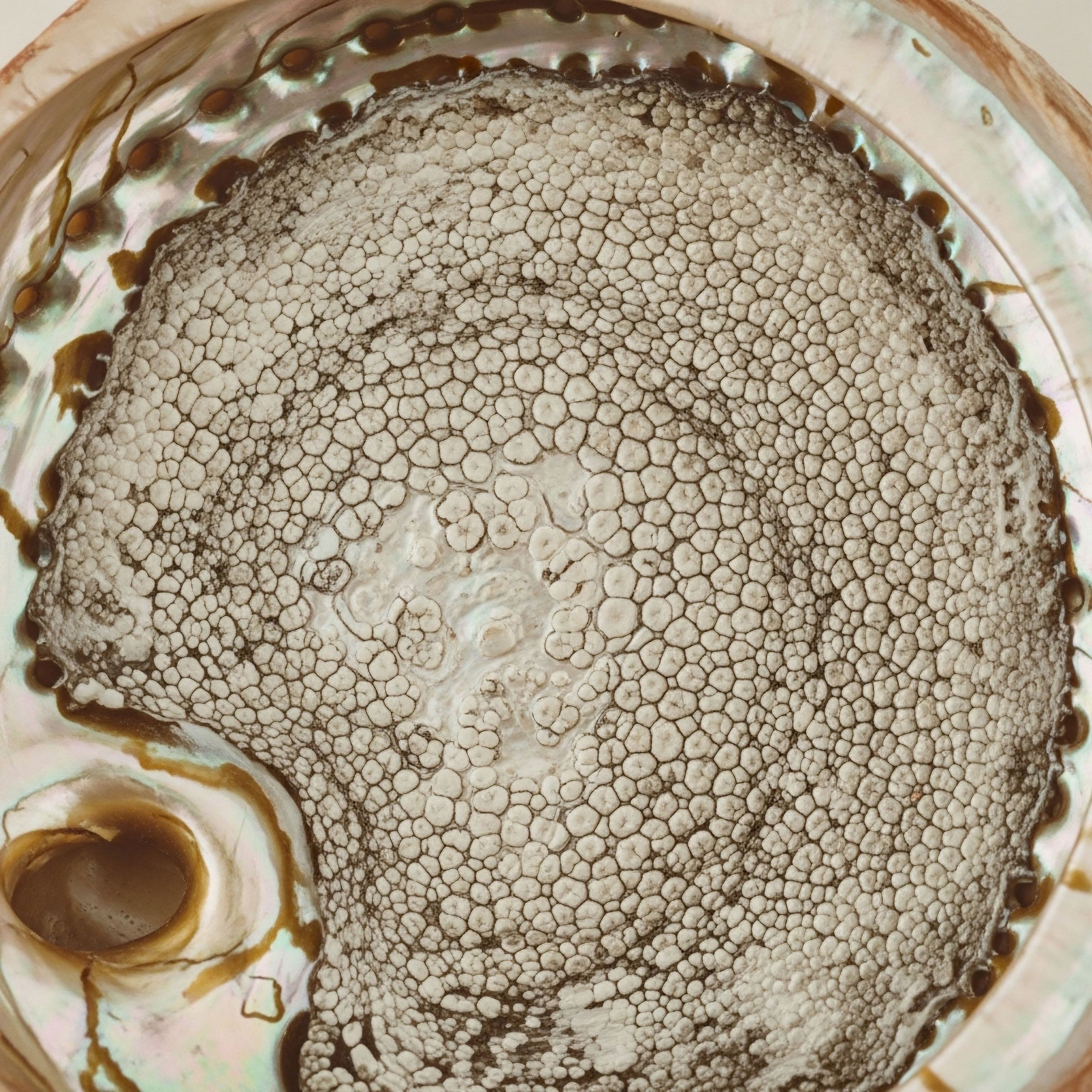

Fundamentals
The path to building a family can present unexpected challenges, and when fertility becomes a concern, the experience is deeply personal. You may feel a sense of disconnection from your own body, a system that suddenly seems to operate by a set of rules you were never taught.
This feeling is a valid and common starting point for many individuals and couples. Understanding the biological architecture that governs reproduction is the first step toward reclaiming a sense of control and making informed decisions. The journey begins not with complex treatments, but with a foundational knowledge of the body’s own intricate communication network.
At the heart of both male and female reproductive function lies a sophisticated and elegant command structure known as the Hypothalamic-Pituitary-Gonadal (HPG) axis. This axis is a continuous feedback loop connecting three critical endocrine glands. The hypothalamus, located in the brain, acts as the mission control center.
It releases a key signaling molecule, Gonadotropin-Releasing Hormone (GnRH), in carefully timed pulses. These pulses travel a short distance to the pituitary gland, another structure in the brain, instructing it to secrete two essential gonadotropins ∞ Luteinizing Hormone (LH) and Follicle-Stimulating Hormone (FSH). These hormones then travel through the bloodstream to the gonads ∞ the testes in men and the ovaries in women ∞ to direct the final, critical actions of reproduction.
The fundamental difference in fertility restoration between men and women stems from the distinct roles the HPG axis plays in orchestrating either continuous sperm production or a cyclical pattern of ovulation.

The Male Reproductive Blueprint
In men, the HPG axis is engineered for consistency. Its primary objective is to maintain a steady state of testosterone production and continuous spermatogenesis (sperm production). FSH acts directly on the Sertoli cells within the testes, which are the nurseries for developing sperm. Simultaneously, LH stimulates the Leydig cells in the testes to produce testosterone.
This testosterone is vital for sperm maturation and also sends feedback signals back to the hypothalamus and pituitary, telling them to modulate the release of GnRH, LH, and FSH, much like a thermostat maintains a constant temperature.
When external testosterone is introduced, as in Testosterone Replacement Therapy (TRT), the brain senses high levels and shuts down its own production of LH and FSH, leading to a halt in natural testosterone and sperm production. Therefore, male fertility restoration often focuses on restarting this entire axis after it has been suppressed.

The Female Reproductive Blueprint
In women, the HPG axis operates with a dynamic, cyclical rhythm that governs the menstrual cycle. The process is designed to prepare and release a single mature egg for fertilization each month. At the beginning of the cycle, FSH stimulates the growth of several follicles within the ovaries.
As these follicles grow, they produce estrogen. Initially, this rising estrogen provides negative feedback to the pituitary, keeping FSH and LH levels in check. However, once a dominant follicle is selected and estrogen levels reach a critical peak, the feedback loop dramatically reverses.
This high level of estrogen triggers a massive surge of LH from the pituitary, which is the direct signal for the mature egg to be released from the ovary ∞ an event known as ovulation.
After ovulation, the remnant of the follicle, now called the corpus luteum, produces progesterone, which prepares the uterine lining for a potential pregnancy and inhibits the HPG axis until the next cycle begins. Female fertility protocols, consequently, are designed to correct disruptions within this intricate cyclical timing, addressing issues like a failure to ovulate or hormonal imbalances that prevent a healthy cycle.
The core distinction is one of process. Male fertility is a continuous production line, while female fertility is a precisely timed, cyclical event. This biological reality dictates why the strategies to restore function are fundamentally different, tailored to either restart a constant system or repair a rhythmic one.


Intermediate
Moving beyond the foundational biology of the HPG axis, we can examine the specific clinical strategies used to restore fertility. These protocols are not one-size-fits-all; they are carefully selected based on the individual’s specific hormonal landscape, the root cause of the infertility, and their personal health history.
The interventions for men and women diverge significantly, reflecting the different operational mechanics of their respective reproductive systems. For men, the goal is often to re-establish the steady-state signaling that drives sperm production. For women, the focus is on re-creating the precise hormonal choreography required for successful ovulation.

Protocols for Restoring Male Fertility
Male infertility, particularly in the context of previous Testosterone Replacement Therapy (TRT), presents a clear challenge ∞ the HPG axis has been deliberately suppressed. Exogenous testosterone provides strong negative feedback to the hypothalamus and pituitary, shutting down the production of LH and FSH. Without these stimulating hormones, the testes cease to produce their own testosterone and, critically, sperm. Restoration protocols are therefore designed to restart this dormant system.
A common approach involves using medications that stimulate the body’s own endocrine pathways. These are often referred to as “post-cycle therapy” or fertility-stimulating protocols. The primary agents used include:
- Selective Estrogen Receptor Modulators (SERMs) ∞ Medications like Clomiphene Citrate (Clomid) and Tamoxifen are central to many male fertility protocols. In men, estrogen, which is produced from the conversion of testosterone, provides powerful negative feedback to the hypothalamus. SERMs work by blocking estrogen receptors in the hypothalamus. The brain is tricked into thinking estrogen levels are low, which prompts it to increase the secretion of GnRH. This, in turn, stimulates the pituitary to release more LH and FSH, effectively “jump-starting” the testes to produce testosterone and sperm again.
- Human Chorionic Gonadotropin (hCG) ∞ This hormone is structurally very similar to LH and acts as an LH mimetic. It can be used to directly stimulate the Leydig cells in the testes to produce testosterone, even when the pituitary is not producing LH. This is particularly useful for maintaining testicular size and function during TRT or for initiating testosterone production as part of a restoration protocol. However, hCG alone does not fully replicate the effect of FSH, which is crucial for spermatogenesis.
- Recombinant FSH (rFSH) ∞ In some cases, particularly when the pituitary itself is unable to produce adequate FSH, direct administration of rFSH may be used to stimulate the Sertoli cells and support sperm maturation.
- Aromatase Inhibitors (AIs) ∞ Drugs like Anastrozole block the enzyme aromatase, which converts testosterone into estrogen. By lowering systemic estrogen levels, AIs can reduce the negative feedback on the HPG axis, thereby helping to increase LH and FSH production.

What Is the Typical Timeline for Male Fertility Recovery?
The recovery of sperm production is not immediate. It takes approximately 74 days for a new sperm cell to fully mature. Therefore, patients are typically advised that it may take three to six months, and sometimes up to a year or more, to see a significant improvement in sperm count after starting a restoration protocol. The success and speed of recovery can be influenced by factors such as the duration of TRT, the patient’s age, and their baseline fertility status.
| Agent | Mechanism of Action | Primary Use in Fertility Restoration |
|---|---|---|
| Clomiphene Citrate (Clomid) | Blocks estrogen receptors at the hypothalamus, increasing GnRH, LH, and FSH secretion. | To restart the entire HPG axis, particularly after TRT suppression or in cases of hypogonadotropic hypogonadism. |
| Human Chorionic Gonadotropin (hCG) | Mimics LH, directly stimulating the testes to produce testosterone. | To maintain testicular function during TRT or to directly stimulate testosterone production as part of a restart protocol. |
| Anastrozole (Arimidex) | Inhibits the conversion of testosterone to estrogen, reducing negative feedback. | Used adjunctively to lower estrogen levels and support the HPG axis restart, especially in men with a high rate of aromatization. |

Protocols for Restoring Female Fertility
Female fertility restoration is centered on correcting disruptions in the menstrual cycle, with the primary goal being to induce monofollicular (single follicle) ovulation. Anovulation, or the failure to ovulate, is a common cause of infertility, often associated with conditions like Polycystic Ovary Syndrome (PCOS). The protocols are designed to stimulate the ovaries in a controlled manner to produce and release a mature egg.
The first line of treatment often involves oral medications:
- Clomiphene Citrate (Clomid) ∞ Similar to its use in men, Clomid acts as a SERM, blocking estrogen receptors at the hypothalamus. This causes the pituitary to increase its output of FSH in the early part of the cycle, which stimulates the ovaries to recruit and grow follicles.
- Letrozole (Femara) ∞ This is an aromatase inhibitor. By blocking estrogen production, Letrozole also reduces negative feedback on the pituitary, leading to an increase in FSH secretion. It has a shorter half-life than Clomid and is often preferred for women with PCOS, as it has been shown to lead to higher live-birth rates in this population.
If oral agents are unsuccessful, or in other specific clinical scenarios, injectable medications are used:
- Gonadotropins ∞ These are injectable forms of FSH, LH, or a combination of both (hMG – human menopausal gonadotropin). They act directly on the ovaries to stimulate follicle development. Their use requires careful monitoring via ultrasound and blood tests to track follicle growth and prevent complications like Ovarian Hyperstimulation Syndrome (OHSS) and high-order multiple pregnancies.
- hCG (Trigger Shot) ∞ Once one or more follicles have reached a mature size (typically 18-20mm), an injection of hCG is administered. Because hCG mimics the natural LH surge, it triggers the final maturation and release of the egg from the follicle approximately 36 hours later.
Protocols for women are meticulously timed to the menstrual cycle, aiming to replicate the natural sequence of hormonal events that lead to ovulation.
| Protocol Step | Agent(s) Used | Objective |
|---|---|---|
| Follicular Recruitment | Clomiphene Citrate or Letrozole (oral); Gonadotropins (injectable) | To stimulate the ovaries to develop one or more mature follicles. |
| Monitoring | Transvaginal Ultrasound, Serum Estrogen Levels | To track follicle growth and endometrial thickness, and to time the trigger shot appropriately while minimizing risks. |
| Ovulation Trigger | hCG Injection (“Trigger Shot”) | To mimic the natural LH surge and induce the final maturation and release of the egg. |
| Luteal Phase Support | Progesterone (oral, vaginal, or injectable) | To support the uterine lining and prepare it for implantation, particularly in cycles using injectable medications or IVF. |
The fundamental divergence in protocols is clear. Male restoration is about reawakening a suppressed, continuous production system. Female restoration is about carefully guiding a complex, cyclical process to its successful culmination. Both require a deep understanding of the HPG axis, but the application of that knowledge is tailored to the unique biological rhythm of each sex.


Academic
A sophisticated analysis of fertility restoration protocols requires moving beyond the simple identification of therapeutic agents and into the realm of neuroendocrine pharmacology. The true elegance and complexity of these interventions lie in their ability to modulate the pulsatile secretion of Gonadotropin-Releasing Hormone (GnRH) from the hypothalamus.
The frequency and amplitude of GnRH pulses are the master variables that differentially regulate the synthesis and release of LH and FSH from the pituitary gonadotrophs, thereby dictating gonadal response. Fertility restoration, at its most fundamental level, is the art of manipulating this pulsatility.

Neuroendocrine Modulation in Male Hypogonadism
In men, the therapeutic use of a Selective Estrogen Receptor Modulator (SERM) like Clomiphene Citrate is a prime example of targeted neuroendocrine manipulation. Clomiphene is a racemic mixture of two isomers, enclomiphene and zuclomiphene, each with distinct pharmacological properties.
Enclomiphene is a potent estrogen receptor antagonist, while zuclomiphene has weaker antagonistic and some agonistic effects, with a much longer half-life. The primary therapeutic effect in men is driven by enclomiphene’s antagonism of estrogen receptors (specifically ERα) on neurons in the arcuate nucleus of the hypothalamus.
This blockade disrupts the negative feedback signal that estrogen normally exerts on GnRH neurons. The hypothalamus interprets this as a state of estrogen deficiency, leading to an increase in both the frequency and amplitude of GnRH pulses. This altered pulse pattern preferentially stimulates the pituitary to secrete more LH and FSH.
The increased LH drives testicular Leydig cells to synthesize more testosterone, raising intratesticular and serum testosterone levels. The concurrent rise in FSH stimulates Sertoli cells, a critical step for initiating and maintaining spermatogenesis. This approach effectively recapitulates the endogenous hormonal cascade, preserving the natural architecture of the reproductive axis. This is a significant advantage over exogenous testosterone administration, which completely bypasses this regulatory system.

How Does Kisspeptin Modulate the HPG Axis?
Emerging research has identified the kisspeptin neuronal system as a critical upstream regulator of GnRH neurons. Kisspeptin, encoded by the KISS1 gene, and its receptor, GPR54, are now understood to be the primary gatekeepers of puberty and potent stimulators of GnRH release.
Sex steroids, like testosterone and estrogen, exert their negative feedback effects on the HPG axis largely by regulating kisspeptin expression in distinct hypothalamic neuronal populations (the arcuate nucleus and the anteroventral periventricular nucleus). Therapeutic agents that can modulate the kisspeptin system hold potential for more precise control over the HPG axis. Kisspeptin-based therapies are being investigated as a novel method to trigger ovulation in women and potentially restore HPG function in men, representing a new frontier in reproductive medicine.

Pharmacological Control of the Female Cycle
In women, the goal of ovulation induction is to manipulate the HPG axis to foster the development of a dominant follicle and trigger its release. The use of Letrozole, an aromatase inhibitor, provides a clear example of how temporary hormonal alteration can achieve a specific physiological outcome.
Letrozole potently blocks the aromatase enzyme, which is responsible for the final step in estrogen biosynthesis. By administering Letrozole for a short course (typically 5 days) in the early follicular phase, systemic estrogen levels are acutely and profoundly suppressed.
This sudden drop in estrogen removes the negative feedback at the level of the pituitary and hypothalamus. The pituitary responds by increasing its secretion of FSH. This temporary surge of FSH is sufficient to rescue more follicles from atresia (degeneration) and stimulate their growth.
Once the Letrozole is discontinued, its short half-life means its inhibitory effect quickly dissipates. The growing cohort of follicles begins to produce estrogen, and as one follicle becomes dominant, its rising estrogen output re-establishes negative feedback on the pituitary, causing FSH levels to fall.
This drop in FSH is a crucial part of selecting a single dominant follicle, as the smaller, less-developed follicles cannot survive without high levels of FSH support. The dominant follicle continues to produce estrogen, eventually reaching the threshold required to initiate the positive feedback loop that triggers the LH surge and ovulation.
The differential half-lives and mechanisms of Clomiphene and Letrozole are key determinants of their clinical application and side effect profiles.
The mechanism of Letrozole contrasts with that of Clomiphene. Clomiphene’s longer half-life, particularly of the zuclomiphene isomer, means that its estrogen receptor-blocking effects can persist later into the cycle. This can sometimes have anti-estrogenic effects on the endometrium and cervical mucus, potentially hindering implantation.
Letrozole’s rapid clearance from the body avoids this issue, allowing the rising estrogen from the developing follicle to have its normal proliferative effect on the uterine lining, creating a more favorable environment for pregnancy. This pharmacological nuance is a primary reason why Letrozole has become the first-line agent for ovulation induction in women with PCOS.
Ultimately, the variation in fertility restoration protocols is a direct reflection of the sexually dimorphic nature of the HPG axis. Male protocols aim to re-establish a tonic, high-frequency GnRH pulse pattern conducive to steady testosterone and sperm production. Female protocols are designed to transiently manipulate the system to generate a specific sequence of hormonal events ∞ an initial FSH rise followed by an estrogen-driven LH surge ∞ that mimics the natural, dynamic rhythm of the ovulatory cycle.

References
- Casper, Robert F. “Letrozole versus clomiphene citrate for infertility in polycystic ovary syndrome.” New England Journal of Medicine, vol. 371, no. 2, 2014, pp. 167-168.
- Crosignani, Pier Giorgio. “Induction of ovulation.” Human Reproduction Update, vol. 12, no. 1, 2006, pp. 23-24.
- Fauser, Bart C. J. M. et al. “Contemporary genetic technologies and female reproduction.” Human Reproduction Update, vol. 25, no. 4, 2019, pp. 377-392.
- George, Julia T. and Waljit S. Dhillo. “The role of kisspeptin in the control of the hypothalamic-pituitary-gonadal axis.” Neuroendocrinology, vol. 91, no. 4, 2010, pp. 329-338.
- Ho, Ken K. Y. et al. “Assessing hypothalamic-pituitary-gonadal function in reproductive disorders.” Endocrine Connections, vol. 12, no. 6, 2023, e230075.
- Huijben, M. et al. “Clomiphene citrate for men with idiopathic oligozoospermia ∞ a systematic review and meta-analysis.” Andrology, vol. 8, no. 5, 2020, pp. 1299-1307.
- Liu, P. Y. et al. “The rate, extent, and modifiers of spermatogenic recovery after hormonal contraception ∞ an integrated analysis.” The Lancet, vol. 363, no. 9419, 2004, pp. 1415-1423.
- Rastrelli, Giulia, et al. “Testosterone replacement therapy and fertility.” Journal of Endocrinological Investigation, vol. 42, no. 12, 2019, pp. 1457-1467.
- The ESHRE Capri Workshop Group. “Health and fertility in World Health Organization group 2 anovulatory women.” Human Reproduction Update, vol. 18, no. 5, 2012, pp. 586-599.
- Wheeler, K. M. et al. “A review of the role of aromatase inhibitors in male infertility.” Journal of Urology, vol. 202, no. 4, 2019, pp. 658-666.

Reflection

Charting Your Own Biological Course
The information presented here offers a map of the intricate biological landscape governing fertility. It details the signals, the pathways, and the clinical strategies designed to restore function to these elegant systems. This knowledge is a powerful tool, transforming abstract feelings of uncertainty into a structured understanding of your own physiology. It provides the vocabulary and the conceptual framework to engage with your health on a deeper level.
Consider the journey you are on. The path forward is one of partnership ∞ between you and the clinical experts who can guide you, and also between you and your own body. The data points on a lab report and the protocols discussed are objective measures, but they find their true meaning when connected to your personal experience and goals.
What does vitality mean to you? How do you define a functional life, free from compromise? Your answers to these questions are the true north on your health compass.
This exploration is the beginning of a dialogue. It equips you to ask more precise questions, to understand the rationale behind a proposed path, and to become an active participant in the process of recalibrating your own biological systems. The ultimate goal is to move from a place of questioning to a position of empowered action, armed with the clarity that comes from understanding the profound connection between your hormones, your health, and your sense of self.



